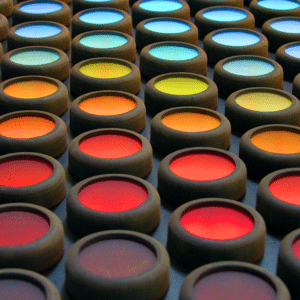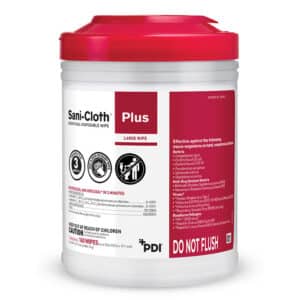(In just 5 minutes)
How to Clean the Everbright: The Official Guide
We get this question all the time: ‘How do you clean The Everbright?‘
It makes sense—kids already touch everything, and the Everbright becomes a magnet for little fingers wherever it’s installed. Hospitals, schools, and libraries want to keep it clean, but no one wants to turn daily maintenance into a full-time job.
It’s simple.
Unlike a touchscreen, the Everbright doesn’t collect fingerprints or smudges because of its textured acrylic surface. And most of the time? You don’t even need to disinfect it.
Here’s everything you need to know, in one place:
✔ The best way to clean the Everbright
✔ What to use (and what not to use)
✔ How hospitals, museums, and schools clean theirs
✔ Video demo (Coming soon!)
The Best Way to Clean The Everbright in 5 Minutes
You Will Need:
✔ 1 black microfiber cloth (for dusting and spot-cleaning in high-traffic locations). Every Everbright comes with one, but you can order more on Amazon or through janitorial suppliers.
✔ Optional: Sani-Cloth Plus Wipes. (A hospital-grade disinfectant wipe. Use if required by your facility.)
How to Clean the Everbright
1. Dust when needed.
- Run a dry (or slightly damp) microfiber cloth down the dials to remove dust.
- Wipe the top of the board where the vents are.
- Done. That’s all most locations need.
- Rapid Cleaning for Large Installations: One high-traffic museum with a 16-foot Everbright cleaned it daily as required using a microfiber blind duster, spraying it with a soap/cleaning solution, then running it all the way down each column of dials. The dials turn, allowing the duster to quickly clean the circumference of all the dials. They finished with a quick wipe to the face of the dials and they were done!
2. If your facility requires disinfection:
- Use Sani-Cloth Plus Wipes (or another approved cleaner. Reference this chart for a list of compatible chemicals).
- Wipe each column, top to bottom.
- Start at the top left dial and work your way down.
3. Never spray the Everbright directly.
The dials have moving parts, and excess liquid can seep into the edges.
2. What Cleaners Are Safe to Use?
We tested six different cleaning agents to see what actually works. Here’s the verdict:
Official Recommendation for the Everbright:
If you must disinfect, use Sani-Cloth Plus Wipes. They’re fast-drying, streak-free, and already approved for hospitals.
3. When & Why to Use Sani-Cloth Plus Wipes
We tested multiple cleaning agents. If your facility requires daily disinfection, Sani-Cloth Plus Wipes are the best option. They:
✔ Are safe for all Everbright materials (including our custom light-reactive acrylic and high-density frame).
✔ Dry quickly (no residue, no streaks, no film).
✔ Are hospital-grade disinfecting wipes (safe for healthcare, schools, libraries).
✔ Require no extra steps (no soap, no drying, no additional cloths).
.Occasional dry dusting with a microfiber cloth is still the best practice for most locations that don’t require daily disinfection.
🚫 If hospitals must use Oxivir, they should wipe away residue with a dry cloth afterward.
🚫 DO NOT use alcohol sprays. Liquids can seep into moving parts. Avoid soaking dials or vents with any cleaning product.
🚫 DO NOT use abrasive cleaners. No Magic Erasers, scrubbing pads, or harsh chemicals.
4. How Do Hospitals & High-Traffic Spaces Clean Their Everbrights?
Most hospitals clean their Everbright daily with disinfecting wipes.
- Why? Infection control policies.
- Does it need to be cleaned that often? Not really—The Everbright doesn’t collect fingerprints like a touchscreen.
- What do hospitals use? Hospital-grade disinfecting wipes.
- Any issues? No reported damage from daily cleaning.
5. How to Clean Between the Dials
Q: How do I clean between the dials?
A: Most of the time, you don’t need to. It’s difficult to reach between them, which means those areas don’t typically collect dirt or fingerprints.
If you really want to clean the entire circumference of every dial:
✔ Hold a microfiber cloth against the edge of the dial and rotate it counterclockwise. This ensures you’re moving against the grain of the sanded cap, preventing fibers from coming off onto the dial.
✔ Run the cloth down the dials in a zig-zag motion. This naturally cleans the edges as the cloth moves between them.
6. What NOT to Do (Common Cleaning Mistakes to Avoid)
🚫 Don’t spray the Everbright directly. Always apply cleaner to a microfiber cloth first.
🚫 Don’t overwipe or overclean if it’s unnecessary. Over-disinfecting can contribute to wear over time.
🚫 Don’t soak the dials. Wipe them—don’t drench them.
🚫 Don’t use abrasive cleaners. No Magic Erasers, scrubbing pads, or harsh chemicals.
7. FAQ: Rapid-Fire Cleaning Answers
Q: Is the Everbright moisture-resistant?
A: Yes. The exterior of the dials and frame is made from an ultra-dense, high-performance architectural material that resists moisture and is naturally non-porous. Unlike traditional wood, it does not require painting and is commonly used in high-end interiors where durability and longevity are essential. However, never spray liquid directly onto the Everbright, or into the vents on the top and bottom of the frame.
Q: What are the Everbright’s lenses made of?
A: A custom-blended, textured acrylic that appears black when unlit and transforms to the color of the light behind it. Unlike standard acrylic, it’s non-glare and fingerprint-resistant.
Q: Do I need to disinfect the Everbright daily?
A: No, unless your facility requires it. Most locations clean it weekly or as needed.
Q: Is cleaning the Everbright like cleaning a touchscreen?
A: No. A touchscreen is a flat surface. The Everbright has hundreds of moving dials.
Q: Can I use Clorox wipes?
A: Safe for the acrylic, but not ideal—they leave foam, streaks, and fibers. We recommend Sani-Cloth Plus Wipes for best results.
Final Takeaways
- The Everbright is easy to clean. Routine dusting is all most locations need.
- Only disinfect if your facility requires it. Over-disinfecting contributes to wear.
- Sani-Cloth Plus Wipes are recommended if disinfection is required.
- Never spray directly onto the dials or the vents on the top of the board.
For more questions or official cleaning recommendations, contact us here: support@hero-design.com or 415-323-5928
This chart shows the chemical resistance of the Everbright’s acrylic to various agents including cleaning chemicals. Dilution is the most important factor–a lower ratio (<15% dilution) is ok, while a higher ratio can be problematic over time.



